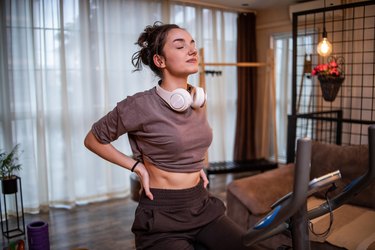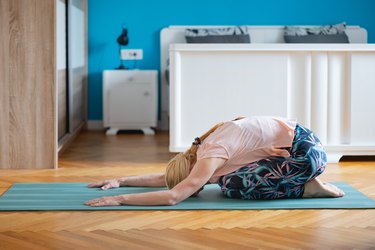
With the appearance of canned pumpkin on supermarket shelves and that unmistakable autumn breeze comes cozy season — and it saturates fashion, food and now even fitness with "let's just stay in" energy.
Enter cozy cardio, a trend spearheaded by TikToker Hope Zuckerbrow, who says in her videos that she wanted to make working out less intimidating and help heal her relationship with exercise. Her version of cardio, the "cozy" variety, involves sipping coffee and watching a relaxing movie while exercising.
Video of the Day
Cozy cardio videos are flooded with comments from fans of the trend, who note it makes exercise feel like a reward and boosts motivation to get moving. That said, the movement does have its critics, too — including those who don't believe it provides an adequate workout.
If you're interested in trying cozy cardio for yourself, here's what you need to know.
What Is Cozy Cardio?
At the core of it, cozy cardio involves creating a soothing and sensory-friendly environment for your exercise. That may mean:
- Using a walking pad in your living room
- Trading loud music for your favorite rom-com
- Turning on ambient lighting and lighting candles
- Adding your favorite scents to the room
- Sipping coffee (Zuckerbrow makes hers with a caramel protein shake and maple brown sugar oat creamer)
- Staying in your pajamas to exercise
Most of these elements are antitheses to typical workouts you may see on social media. With cozy cardio, there are no fluorescent gym lights, loud music, clanking of weights or tight-fitting workout clothes.
"The best exercise is an exercise that you enjoy doing and, more importantly, that you can fit into your lifestyle," says Brittany Werner, RDN, NASM-CPT, a certified personal trainer and coach for Working Against Gravity, a one-on-one nutrition coaching program. "This trend is removing the stereotypical societal norms around fitness — and that can only be a good thing for those who have shied away in the past."
Cozy cardio doesn't involve rigorous workouts. You may reach a brisk walk or do a few minutes of moderate intensity cardio before cooling down.
Watch One of Hope Zuckerbrow's Cozy Cardio Videos Here:
What Are the Benefits of Cozy Cardio?
1. It Makes Exercise More Accessible
Perhaps the most notable benefit of cozy cardio is that it makes exercising more approachable for those who may otherwise be deterred by sterile gyms or high-energy classes.
"Cozy cardio allows you to be in a welcoming, non-intimidating environment while you fit fitness into your schedule," Werner says.
The idea of cozy cardio also removes the "all-or-nothing" thinking that can sometimes throw off fitness routines.
It's recommended that adults get 2.5 hours of moderate-intensity physical activity per week, along with muscle-strengthening activities two days per week, according to the U.S. Department of Health and Human Services.
That may mean turning on your favorite TV show and doing cozy cardio for 30 minutes per day every weekday. Cozy cardio removes the intimidation of the time-stamped TikTok routines you may see that show influencers working out for one to two hours daily.
Researchers found that risk of early death was about 30 percent lower in active versus inactive adults in a January 2017 study in JAMA Internal Medicine. Those active adults included weekend warriors (people who got the recommended amount of exercise, but in less frequent sessions of one or two days per week) and insufficient exercisers (those who got some exercise but didn't meet weekly recommendations). Regular exercisers lowered their risk more than weekend warriors and insufficient exercisers, but some activity still made a difference.
"Weekend warrior and other leisure time physical activity patterns characterized by one or two sessions per week may be sufficient to reduce all-cause, cardiovascular disease and cancer mortality risks, regardless of adherence to prevailing physical activity guidelines," note the authors in the study.
In other words: Getting the recommended amount of exercise is best, but some is better than none — and cozy cardio can help you get there.
2. It Can Lower Your Stress levels
Many people find the clanking and bright lights of typical fitness environments overwhelming and the machinery intimidating to navigate. In fact, the anxious feelings the gym can provoke has been dubbed "gymtimidation."
However, exercise is key for reducing anxiety. It can decrease muscle tension, change your brain chemistry to increase anti-anxiety neurochemicals and activate frontal regions of the brain that help control our fight-or-flight reactions, per Harvard Health Publishing.
Because of that, it's important to find a form of exercise that doesn't stoke anxious feelings for you in the first place, which is where cozy cardio may come into play.
"Cozy cardio can improve mental health by reducing stress and anxiety," says Ashley Castleberry, NASM-CPT, a certified personal trainer at TGFFitness, an educational fitness platform. "The relaxing environment helps lower cortisol levels, while the sense of accomplishment boosts endorphins and self-esteem. This can help improve conditions like depression, OCD and PTSD."
3. It Offers a Form of Gentle Exercise
Cozy cardio can help prevent injuries by providing a form of low-impact, gentle exercise.
"The lack of pounding, joint stress and excessive weights helps to avoid damage to areas like the knees, hips and back," Castleberry says. It also allows for people to gradually come back from injuries, pregnancy or surgery, or start an exercise routine if they're new to working out.
Low-intensity exercise offers benefits like deeper breathing and coordinating movements, per Memorial Sloan Kettering Cancer Center. These types of exercise can help improve mobility, stamina and stability.
4. It Helps You Maintain Habits
You're more likely to stick with exercise routines you enjoy. By surrounding yourself with your favorite entertainment, scents, sips and lighting, you're creating a workout habit that you actually look forward to.
"Being in an environment that brings you joy will only increase the likelihood of continuing the behavior," Werner says. "I'm a fan of anything that lowers the barrier of entry for activity."
Plus, it eliminates the excuses that might otherwise prevent you from getting out the door for a workout, like having to put on certain clothes or drive to another location.
"It counteracts obstacles like intimidating gyms, bad weather, lack of equipment, time constraints or lack of motivation," Castleberry says.
What Are the Drawbacks of Cozy Cardio?
1. It May Be Too Low-Intensity
While it may be calming, cozy cardio doesn't give you the bursts of heart-pumping exercise that can be beneficial.
"With a limited cardio challenge and no strength training, your cardiovascular fitness, muscle tone and calorie burn may not progress significantly," Castleberry says.
Even the soothing atmosphere can affect how your body reacts to exercise.
"Cozy cardio is known for soft lighting and calm vibes, but this atmosphere often won't get your heart rate up and spike motivation quite like a brighter, louder environment," Werner says.
Typically, high-intensity exercise means upping your heart rate to more than 70 percent of your maximum heart rate, per the Cleveland Clinic. The basic formula for this is 220 minus your age.
While you should speak to your doctor before starting a new regimen, high-intensity exercise may be important to include in your routine if you have certain goals in mind.
"Cozy cardio is not suitable for some goals, like weight loss or athletic performance," Castleberry says "Those seeking fat loss, muscle gain or sport-specific training need higher intensities and progressive overload."
2. It Doesn’t Have a Community Element
Cozy cardio is typically done alone, which means you miss out on the camaraderie you could enjoy in a class or even at a gym.
"Consistent solo exercise may negatively impact your mood over time," Castleberry says. Scheduling workout sessions with a friend or fitness group can help combat that.
People who feel more connected in their exercise classes attend more sessions are more likely to stick with it, are more resilient to disruptions and are more likely to have greater mental benefits from the exercise, per a January 2019 review in Exercise and Sport Sciences Reviews.
If you take on cozy cardio alone, consider teaming up with a friend. Commit to doing your cozy cardio routines at the same time each day — and perhaps even watch the same TV show or movie together as you do so.
3. You Typically Need Cardio Equipment
Cozy cardio is associated with equipment like a walking pad, which may not be feasible for everyone, depending on space and budget.
"Many traditional cardio workouts depend on someone having a piece of equipment and ample space at home, making this another barrier for those in smaller spaces or lacking such equipment," Werner says.
Plus, if your lighting is low, you'll need to be cautious about tripping risks.
"If you're new to a walking pad, stationary bike or any other equipment, you may want to err on the side of more light as you start your cozy cardio journey," Werner says.
A Sample Cozy Cardio Workout
Cozy cardio can look however you want it to — after all, what's cozy for you may be unique! However, Werner recommends this sample workout to get started.
Step 1: Put on your comfortable workout clothes. Feel your best and get ready to move!
Step 2: Set the scene. Make the space somewhere you want to be. Maybe that's by lighting candles or incense and putting on your favorite music. Play a movie or look out the window at the sunrise or sunset — whatever brings you joy.
Step 3: Warm up at a slow pace for 5 minutes by using any piece of cardio equipment (walking pad, treadmill, bike, rower, etc.). This will wake up your body and get you ready to move. Aim for a slow pace where you could still have a full conversation without getting winded.
Step 4: Ramp up to a steady pace where you're working harder, but you can hold it for 20 minutes. This is likely a seven out of ten rate of perceived exertion, but you know your own limits. If you need to slow down, that's OK, but try not to stop!
Step 5: Slow back down to the warm-up pace for 5 minutes to allow your body to return to a lower heart rate and begin cooling down.
The Bottom Line
Cozy cardio is a great way to get moving, especially if you're prone to avoiding the gym and other forms of exercise. It can make workout routines more accessible, lower your stress levels and offer a form of gentle exercise.
That said, it may not provide enough of a workout to help you reach certain weight loss or performance goals. You also miss out on the community element of working out with others and may need to invest in your own cardio equipment.
Before starting any new workout routine, talk to your doctor. Together, you can determine the best workout options for your goals, which may very well include cozy cardio.
- U.S. Department of Health and Human Services: "Physical Activity Guidelines for Americans"
- JAMA Internal Medicine: "Association of 'Weekend Warrior' and Other Leisure Time Physical Activity Patterns With Risks for All-Cause, Cardiovascular Disease, and Cancer Mortality"
- Harvard Health Publishing: "Can exercise help treat anxiety?"
- Memorial Sloan Kettering Cancer Center: "Low-intensity exercise"
- Cleveland Clinic: "High-Intensity Interval Training (HIIT): It’s for Everyone!"
- Exercise and Sport Science Reviews: "Promoting Exercise Adherence Through Groups: A Self-Categorization Theory Perspective"



